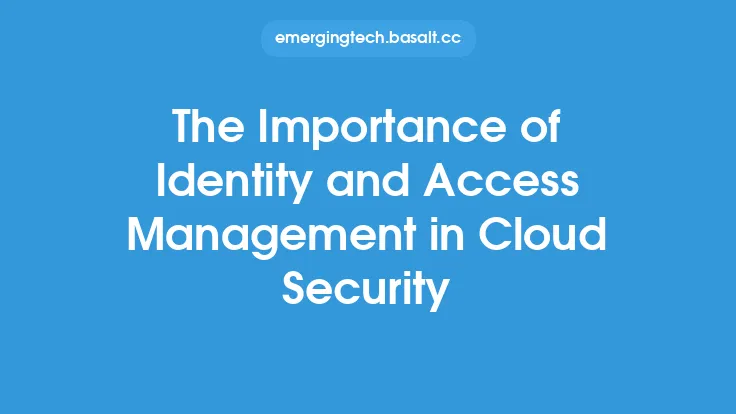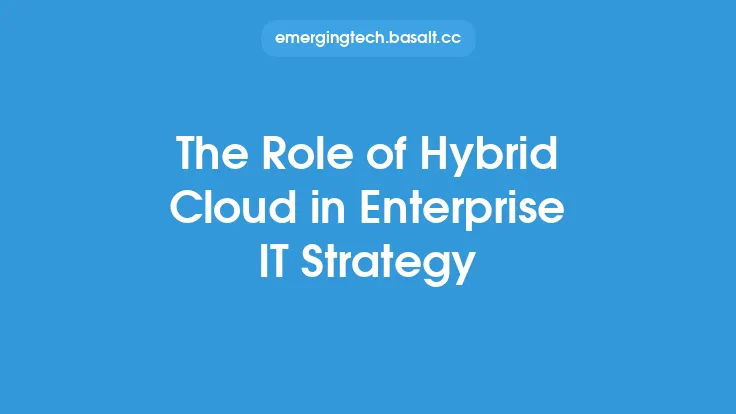The increasing adoption of cloud computing has led to a growing concern about the security, compliance, and governance of cloud-based systems. As organizations move their data and applications to the cloud, they must ensure that their cloud service providers (CSPs) adhere to relevant laws, regulations, and industry standards. Auditing plays a crucial role in cloud compliance and governance, as it helps organizations verify that their CSPs are meeting the required standards and regulations. In this article, we will delve into the role of auditing in cloud compliance and governance, exploring its importance, types, and best practices.
Introduction to Cloud Auditing
Cloud auditing is the process of examining and evaluating the cloud-based systems, infrastructure, and applications to ensure that they comply with relevant laws, regulations, and industry standards. Cloud auditing involves assessing the CSP's controls, processes, and procedures to identify any vulnerabilities, risks, or non-compliance issues. The primary goal of cloud auditing is to provide assurance that the CSP is meeting the required standards and regulations, thereby protecting the organization's data and applications.
Types of Cloud Audits
There are several types of cloud audits, each with its own specific objectives and scope. The most common types of cloud audits include:
- SOC 1 (Service Organization Control 1) audit: Focuses on the CSP's internal controls over financial reporting.
- SOC 2 (Service Organization Control 2) audit: Evaluates the CSP's internal controls over security, availability, processing integrity, confidentiality, and privacy.
- SOC 3 (Service Organization Control 3) audit: Provides a high-level overview of the CSP's internal controls over security, availability, processing integrity, confidentiality, and privacy.
- ISO 27001 (International Organization for Standardization 27001) audit: Assesses the CSP's information security management system (ISMS) against the ISO 27001 standard.
- PCI-DSS (Payment Card Industry Data Security Standard) audit: Evaluates the CSP's compliance with the PCI-DSS standard for handling payment card information.
- HIPAA (Health Insurance Portability and Accountability Act) audit: Assesses the CSP's compliance with the HIPAA regulations for handling protected health information (PHI).
Cloud Auditing Process
The cloud auditing process typically involves the following steps:
- Planning and preparation: Identify the scope, objectives, and requirements of the audit.
- Risk assessment: Identify potential risks and vulnerabilities in the cloud-based system.
- Audit procedures: Develop and execute audit procedures to test the CSP's controls and processes.
- Evidence collection: Collect and analyze evidence to support the audit findings.
- Reporting: Prepare and present the audit report to stakeholders.
- Follow-up: Conduct follow-up audits to ensure that any identified issues have been addressed.
Best Practices for Cloud Auditing
To ensure effective cloud auditing, organizations should follow best practices, including:
- Clearly define the audit scope and objectives: Ensure that the audit scope and objectives are clearly defined and aligned with the organization's compliance and governance requirements.
- Use experienced auditors: Engage experienced auditors who have expertise in cloud computing and auditing.
- Leverage automation tools: Leverage automation tools to streamline the audit process and improve efficiency.
- Conduct regular audits: Conduct regular audits to ensure ongoing compliance and governance.
- Monitor and report: Continuously monitor the CSP's controls and processes and report any issues or concerns to stakeholders.
Challenges and Opportunities in Cloud Auditing
Cloud auditing presents several challenges, including:
- Complexity: Cloud-based systems can be complex and difficult to audit.
- Lack of visibility: Organizations may have limited visibility into the CSP's controls and processes.
- Regulatory requirements: Cloud auditing must comply with various regulatory requirements, which can be challenging.
Despite these challenges, cloud auditing also presents opportunities, including:
- Improved compliance: Cloud auditing can help organizations improve their compliance with relevant laws, regulations, and industry standards.
- Enhanced governance: Cloud auditing can help organizations enhance their governance and risk management practices.
- Increased transparency: Cloud auditing can provide increased transparency into the CSP's controls and processes.
Conclusion
In conclusion, auditing plays a critical role in cloud compliance and governance. By conducting regular audits, organizations can ensure that their CSPs are meeting the required standards and regulations, thereby protecting their data and applications. To ensure effective cloud auditing, organizations should follow best practices, including clearly defining the audit scope and objectives, using experienced auditors, leveraging automation tools, conducting regular audits, and monitoring and reporting. By doing so, organizations can improve their compliance, enhance their governance, and increase transparency into their CSP's controls and processes. As cloud computing continues to evolve, the importance of cloud auditing will only continue to grow, making it essential for organizations to prioritize cloud auditing as part of their overall compliance and governance strategy.





